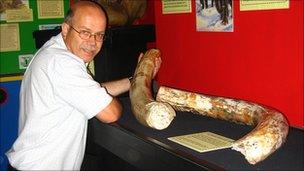Woolly mammoth tusks found in sea on show in Dorchester
- Published

The tusks are discoloured from being in the sea for thousands of years
A pair of 20,000-year-old woolly mammoth tusks trawled up from the bottom of the North Sea are going on display at a Dorset museum.
They form the centrepiece of a display on mammoths at the Dinosaur Museum in Dorchester.
Their tusks could grow to 5m (16ft) but only 1.5m (5ft) sections are on show.
At the time the animal died the North Sea did not exist and the area was low-lying grassland connecting the British Isles to the continent.
When the North Sea formed at the end of the last ice age, the tusks became buried in the thin layers of sand at the bottom of the shallow southern part of it.
They remained there for thousands of years and eventually tidal currents and dredging released the fossilised remains, which were caught in the fishing nets of a trawler earlier this year.
Climate change
Tim Batty, curator of the Dinosaur Museum, said the tusks were unusually coloured because they had been in water for so long.
He said: "The new display comes at a time when new research has revealed that humans were not responsible for the extinction of the mammoths.
"It had traditionally been thought that mammoths had been hunted to extinction.
"However it now appears that it was climate change that caused their extinction.
"Mammoths were well adapted to the low temperatures of the ice age.
"The climatic conditions during the ice age did not favour the growth of trees and consequently there were extensive grasslands for the mammoths to graze on.
"However with the end of the ice age and the warming of temperatures, tree growth accelerated causing a spread of forests and dramatically reducing the available food supply for mammoths."
- Published18 August 2010